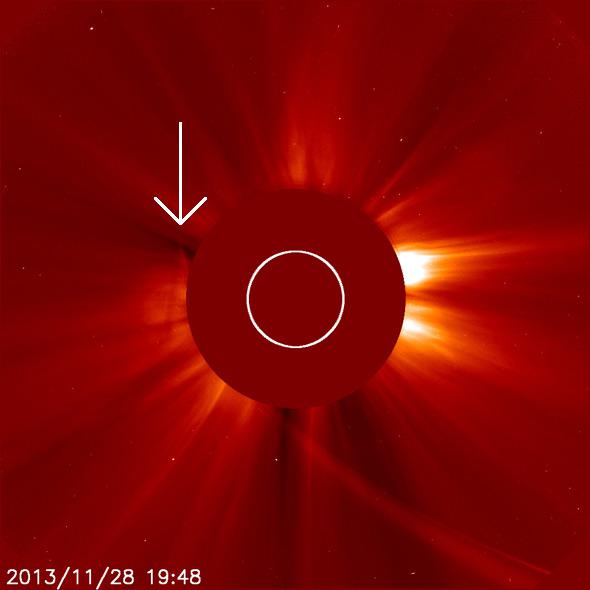Comet ISON is headed for a very, very hot date with the Sun. At roughly 18:37 UTC today (1:37 p.m. EST) it will be at perihelion, its closest approach to the Sun, broiling away just 1.1 million kilometers (700,000 miles) above the star’s surface.

Photo by NASA / ESA / SOHO / Helioviewer.org
[UPDATE (Nov. 28 at 18:20 UTC): I have added a new SOHO image here, taken at 17:24 UTC (12:24 EST). It’s a combination of a wide and narrow view, and the nucleus is not nearly as obvious. I don’t want to speculate, but it’s possible we’re seeing that the nucleus has broken up. Hopefully more updates from the Solar Dynamics Observatory will show more detail.]

Photo by NASA / ESA / SOHO / Helioviewer.org
[UPDATE 2 (Nov. 28 at 18:45 UTC): An image of ISON from 17:48 (20 minutes after the one above) shows the comet even more stretched out. If the solid nucleus were intact it wouldn’t be so smeared out, and more telling, the comet fades and narrows to the upper left, in the direction of its motion. That’s exactly what you’d expect if the comet has broken up.]

Photo by NASA / ESA / SOHO
[UPDATE 3 (Nov. 28 at 20:30 UTC): The latest SOHO image I can grab is from 19:48 UTC (2:48 EST) and it seems to show a little bit of ISON coming around the Sun. However, it once again appears to not be condensed, meaning it looks like debris smeared out along the comet’s orbit. It looks to me that ISON, as a solid body, is no more. The next question is, when did the breakup actually occur? Was it it an all-at-once event, or did it break up over time? It may have happened before it even entered the SOHO field of view, and the pieces didn’t disperse until after it got near the Sun this morning.]
At the same time, starting at 18:00 UTC, there will be a NASA live video chat on Google+ with several scientists, including me (I will be there at 18:30) talking about ISON, comets, and what we can expect from this event. If you have a Google+ account you can watch it there, or I have embedded the live YouTube video feed below.
If you want to ask questions, you can submit them via Twitter using the #askNASA or #ISON hashtags.
I’ve already written about ISON several times, so if you’d like more info I suggest checking the links below, and the links therein for that matter.
My blog:
Quick ISON Update: Dimmed but Still Rocking
12 Cool Facts About Comet ISON [with followup: An Inescapable Error]
UPDATE: Is Comet ISON Heading for Interstellar Space?
Quick ISON Update: Is It Still There?
Comet ISON: Hubble Image Shows It Still Lives
Comet ISON Is (So Far) Living up to the Hype
Comet ISON: Still Alive and Kicking
Other sources:
Real time images from the Solar Dynamics Observatory
Planetary Society live blog updates
Comet ISON Observing Campaign
Twitter:
